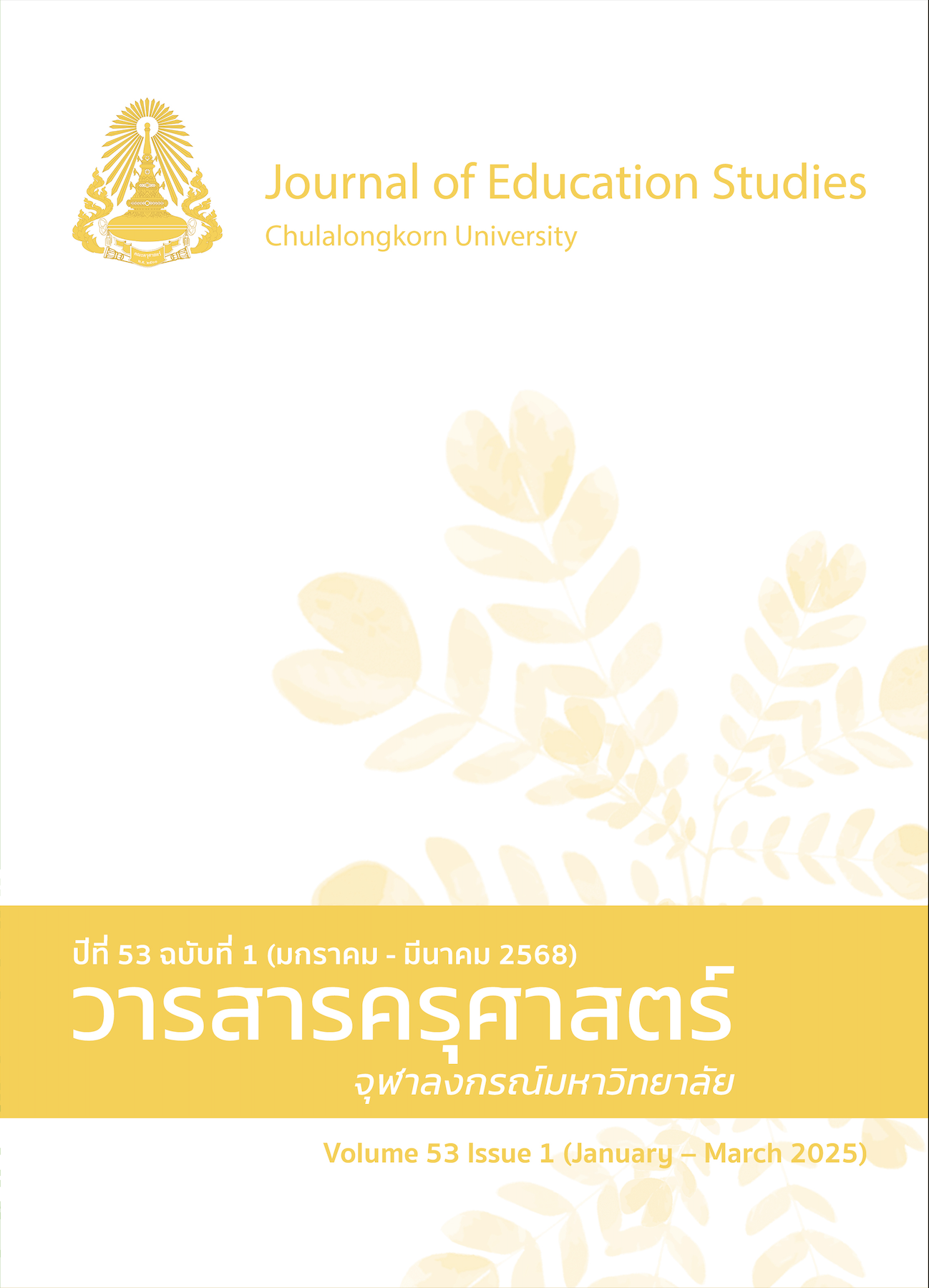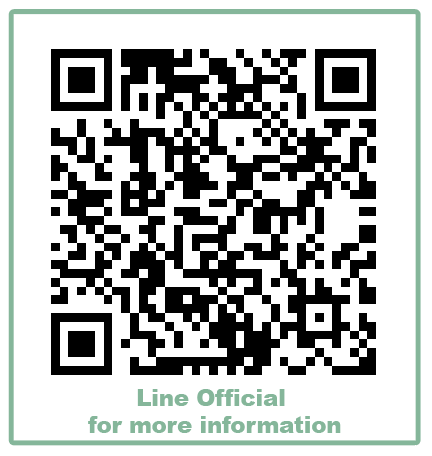แนวทางการสนับสนุนเพื่อส่งเสริมกรอบความคิดแบบเติบโตด้านการพูดในที่สาธารณะสำหรับนักเรียนมัธยมศึกษาตอนปลายที่เรียนภาษาอังกฤษเป็นภาษาต่างประเทศ
คำสำคัญ:
การสนับสนุนจากครู, กรอบความคิดแบบเติบโต, การพูดในที่สาธารณะ, นักเรียนที่เรียนภาษาอังกฤษในฐานะภาษาต่างประเทศบทคัดย่อ
การพูดในที่สาธารณะที่มีประสิทธิภาพเป็นทักษะสำคัญในบริบทของการเรียนการสอนภาษาอังกฤษเป็นภาษาต่างประเทศ อย่างไรก็ตาม นักเรียนจำนวนมากยังคงประสบกับความวิตกกังวลและขาดความมั่นใจ ซึ่งมักได้รับอิทธิพลจากกรอบความคิดของตนเอง งานวิจัยนี้มีวัตถุประสงค์เพื่อ 1) สำรวจความสัมพันธ์ระหว่างการสนับสนุนจากครูและกรอบความคิดด้านการพูดในที่สาธารณะ และ 2) เสนอแนวทางการสนับสนุนเพื่อส่งเสริมกรอบความคิดแบบเติบโตด้านการพูดในที่สาธารณะสำหรับนักเรียนมัธยมศึกษาตอนปลายที่เรียนภาษาอังกฤษเป็นภาษาต่างประเทศ การวิจัยใช้วิธีวิจัยแบบลำดับขั้นตอนสองระยะ ระยะที่ 1 มีการเก็บข้อมูลเชิงปริมาณจากนักเรียนมัธยมศึกษาปีที่ 6 จำนวน 250 คน จากโรงเรียนรัฐบาลขนาดใหญ่พิเศษ 5 แห่งในกรุงเทพมหานคร ใช้แบบสอบถามและข้อมูลเชิงคุณภาพจากการสัมภาษณ์นักเรียน ระยะที่ 2 เก็บข้อมูลเชิงคุณภาพจากครูและนักวิชาการจำนวน 5 ท่าน และครูชำนาญการพิเศษจำนวน 3 ท่าน ประเมินแนวทางการสนับสนุน วิเคราะห์ข้อมูลเชิงปริมาณโดยใช้สถิติเชิงบรรยายและการวิเคราะห์สหสัมพันธ์เพียร์สัน วิเคราะห์ข้อมูลเชิงคุณภาพโดยใช้การวิเคราะห์แก่นสาระ ผลการวิจัย พบว่า การสนับสนุนทางอารมณ์และการให้การประเมินผลจากครูมีความสัมพันธ์เชิงบวกกับกรอบความคิดแบบเติบโตด้านการพูดในที่สาธารณะอย่างมีนัยสำคัญทางสถิติที่ระดับ .001 (r = 0.200) ผลการวิจัย พบว่า แนวทางการสนับสนุนประกอบด้วย 4 องค์ประกอบหลัก ได้แก่ 1) การสร้างความมั่นใจผ่านการให้กำลังใจ 2) การจัดหาทรัพยากรเพื่อพัฒนาทักษะ 3) การชี้แนะผ่านการให้คำแนะนำเชิงสร้างสรรค์ และ 4) การสร้างบรรยากาศการเรียนรู้แบบร่วมมือ แนวทางการสนับสนุนที่พัฒนาขึ้นสามารถนำไปประยุกต์ใช้ในการฝึกอบรมครูและการออกแบบหลักสูตรเพื่อส่งเสริมการพัฒนากรอบความคิดแบบเติบโตและความมั่นใจของนักเรียนด้านการพูดในที่สาธารณะ
References
Bandura, A. (1997). Self-Efficacy: The exercise of control. W.H. Freeman and Company.
Cohen, J. (1988). Statistical power analysis for the behavioral sciences (2nd Ed.). Lawrence Erlbaum Associates.
Cui, M., Hua, J., Shi, X., Yang, W., Geng, Z., Qian, X., & Geng, G. (2022). Factors associated with instrumental support in transitional care among older people with chronic disease: A cross-sectional study. BMC Nursing, 21(1). https://doi.org/10.1186/s12912-022-01014-w
Docan-Morgan, T., & Nelson, L. (2015). The benefits and necessity of public speaking education. In T. Docan-Morgan (Ed.), Public speaking for the curious (pp. 1–16). The Curious Academic. https://www.researchgate.net/publication/332974615_The_Benefits_and_Necessity_of_Public_Speaking_Education
Dweck, C. S. (2016). Mindset: The new psychology of success. Random House.
Gauthreaux, E. E. (2015). Effect of specific feedback on growth mindset and achievement [Master's thesis, Louisiana State University and Agricultural and Mechanical College]. LSU Digital Commons. https://repository.lsu.edu/gradschool_theses/3259
Hafifah, G. N., & Anggraini, R. D. (2023). Factors influencing students speaking skills: Social support and speaking anxiety. UNNES-TEFLIN National Conference, 5, 294–301. https://proceeding.unnes.ac.id/utnc/article/view/2618
House, J. S. (1981). Work stress and social support. Addison Wesley.
Jennings, C., & Cuevas, J. A. (2021). Teacher impact on student growth mindset. Perspectives In Learning, 9(1), 23–38. https://csuepress.columbusstate.edu/pil/vol19/iss1/4
Jones, S. M., & Koerner, A. F. (2015). Support types. The International Encyclopedia of Interpersonal Communication, 1–9. https://doi.org/10.1002/9781118540190.wbeic166
Kristensen, S. M., Jørgensen, M., Meland, E., & Urke, H. B. (2023). The effect of teacher, parental, and peer support on later grade point average: The mediating roles of self-beliefs. Psychology in the Schools, 60(7), 2342–2359. https://doi.org/10.1002/pits.22865
Kurakan, P. (2021). Anxiety in English oral presentations of Thai EFL engineering students. Thaitesol Journal, 34(2), 67–92. https://so05.tci-thaijo.org/index.php/thaitesoljournal/article/view/256486
Lou, N. M., & Noels, K. A. (2019). Language mindsets, meaning-making, and motivation. In M. Lamb, K. Csizér, A. Henry, & S. Ryan (Eds.), The palgrave handbook of motivation for language learning (pp. 537–559). Palgrave Macmillan. https://doi.org/10.1007/978-3-030-28380-3_26
Lucas, S. E. (2009). The art of public speaking (10th Edition). McGraw Hill.
McCroskey, J. C. (1977). Oral communication apprehension: A summary of recent theory and
research. Human Communication Research, 4(1), 78–96. https://doi.org/10.1111/j.1468-2958.1977.tb00599.x
Mercer, S., & Ryan, S. (2010). A mindset for EFL: Learners’ beliefs about the role of natural talent. ELT Journal, 64(4), 436–444. https://doi.org/10.1093/elt/ccp083
Nadia, H., & Yansyah, Y. (2018). The effect of public speaking training on students’ speaking anxiety and skill. Proceeding of the 65th TEFLIN International Conference, 65(1), 227–232. https://ojs.unm.ac.id/teflin65/article/view/6276/3615
Patrick, H., Ryan, A. M., & Kaplan, A. (2007). Early adolescent’ perceptions of the classroom social environment, motivational beliefs, and engagement. Journal of Educational Psychology, 99(1), 83–98. https://doi.org/10.1037/0022-0663.99.1.83
Raja, F. (2017). Anxiety level in students of public speaking: Causes and remedies. Journal of Education and Educational Development, 4(1), 94–110. https://files.eric.ed.gov/fulltext/EJ1161521.pdf
Sadoughi, M., & Hejazi, S. Y. (2023). Teacher support, growth language mindset, and academic engagement: The mediating role of l2 grit. Studies in Educational Evaluation, 77, 101251. https://doi.org/10.1016/j.stueduc.2023.101251
Sampasivam, S., & Clément, R. (2014). 3. The dynamics of second language confidence: Perspective and interaction. In S. Mercer & M. Williams (Eds.), Multiple perspectives on the self in SLA (pp. 23–40). Multilingual Matters. https://doi.org/10.21832/9781783091362-004
Stewart, C. O., McConnell, J. R., Stallings, L. A., & Roscoe, R. D. (2017). An initial exploration of students’ mindsets, attitudes, and beliefs about public speaking. Communication Research Reports, 34(2), 180–185. https://doi.org/10.1080/08824096.2016.1270821
Tantiwicha, K., & Sinwongsuwat, K. (2021). Thai university students’ problems of language use in English conversation. Learn Journal: Language Education and Acquisition Research Network, 14(2), 598–626. https://so04.tci-thaijo.org/index.php/learn/article/view/253282
Wu, J.-J., Khan, H. A., Chien, S.-H., & Lee, Y.-P. (2019). Impact of emotional support, informational support, and norms of reciprocity on trust toward the medical aesthetic community: The moderating effect of core self-evaluations. Interactive Journal of Medical Research, 8(1), 1–12. https://doi.org/10.2196/11750
Yeager, D. S., & Dweck, C. S. (2012). Mindsets that promote resilience: When students believe that personal characteristics can be developed. Educational Psychologist, 47(4), 302–314. https://doi.org/10.1080/00461520.2012.722805
Yeager, D. S., & Walton, G. M. (2011). Social-psychological interventions in education: They’re not magic. Review of Educational Research, 81(2), 267–301. https://doi.org/10.3102/0034654311405999
Downloads
เผยแพร่แล้ว
How to Cite
ฉบับ
บท
License

This work is licensed under a Creative Commons Attribution-NonCommercial-NoDerivatives 4.0 International License.



